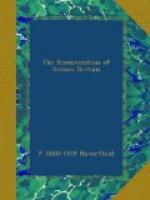[Footnote 1: Jerome, Comment. in epist. ad Galatas, ii. 3. His assertion has, however, met with much scepticism in modern times, and it must be admitted that he was not a very accurate writer.]
[Footnote 2: K. Holl, Hermes, xliii. 240-54; William M. Ramsay, Oesterr. Jahreshefte, viii. (1905), 79-120, quoting, amongst other things, a neo-phrygian text of A.D. 259; W.M. Calder, Hellenic Journal, xxxi. 161.]
[Footnote 3: Mommsen (Roem. Gesch. v. 92) ascribes the final extinction of Celtic in northern Gaul to the influence of the Church. But the Church was not in itself averse to native dialects, and its insistence on Latin in the west may well be due rather to the previous diffusion of the language.]
In material culture the Romanization advanced no less quickly. One uniform fashion spread from the Mediterranean throughout central and western Europe, driving out native art and substituting a conventionalized copy of Graeco-Roman or Italian art, which is characterized alike by its technical finish and neatness, and by its lack of originality and its dependence on imitation. The result was inevitable. The whole external side of life was lived amidst Italian, or (as we may perhaps call it) Roman-provincial, furniture and environment. Take by way of example the development of the so-called ‘Samian’ ware. The original manufacture of this (so far as we are here concerned) was in Italy at Arezzo. Early in the first century Gaulish potters began to copy and compete with it; before long the products of the Arretine kilns had vanished even from the Italian market. Western Europe henceforward was supplied with its ‘best china’ from provincial and mainly from Gaulish sources. The character of the ware supplied is significant. It was provincial, but it was in no sense unclassical. It drew many of its details from other sources than Arezzo, but it drew them all from Greece or Rome. Nothing either in the manner or in the matter of its decoration recalled native Gaul. Throughout, it is imitative and conventional, and, as often happens in a conventional art, items are freely jumbled together which do not fit into any coherent story or sequence. At its best, it is handsome enough: though its possibilities are limited by its brutal monochrome, it is no discredit to the civilization to which it belongs. But it reveals unmistakably the Roman character of that civilization.
The uniformity of this civilization was crossed by local variations, but these do not contradict its Roman character. If the provincial felt sometimes the claims of his province and raised a cry that sounds like ‘Africa for the Africans’ he acted on a geographical, not on any native or national idea. He was demanding individual life for a Roman section of the Empire. He was anticipating, perhaps, the birth of new nations out of the Romanized populations. He was not attempting to recall the old pre-Roman




